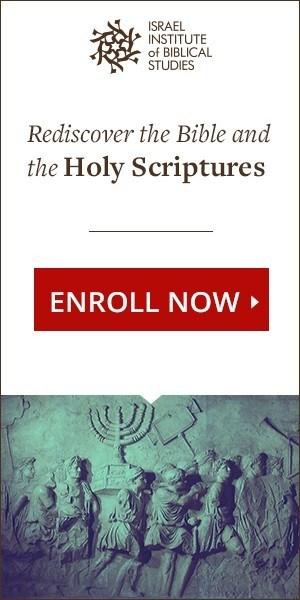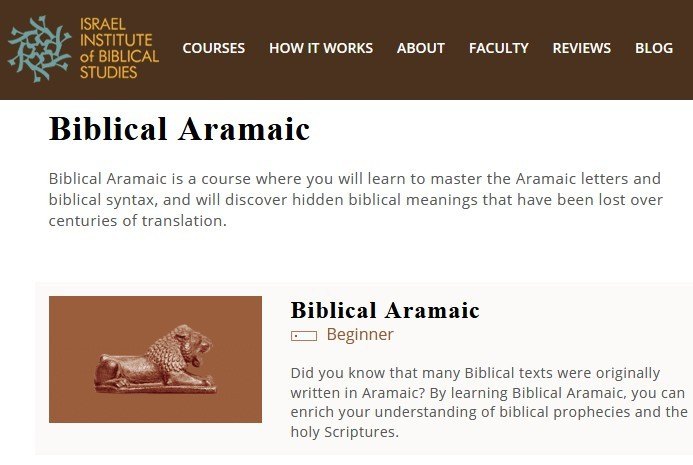Many people know that the original texts of the Bible were written in Hebrew. But did you know that some were also written in a language known as Aramaic? This is a language that is related to Hebrew and even overtook Hebrew in popularity at one point in time. A few entire books of the Hebrew Bible are written in Aramaic but you can also find passages of Aramaic and loan words sprinkled throughout the sections of the Bible that are written in Hebrew. If you want to study the Bible, learning Aramaic language is another way to gain the most knowledge you can.
 About the Israel Institute of Biblical Studies
About the Israel Institute of Biblical Studies
The Israel Institute of Biblical Studies is an important and recognized partner of the Hebrew University of Jerusalem. Because of this partnership, any course you take through them is accredited so you can earn college credit through their online courses.
They offer courses in Ancient Hebrew, Modern Hebrew, Biblical Aramaic, Biblical Greek, and Yiddish. You can also take courses in Jewish and Biblical Studies, such as Exploring the Biblical Land of Israel, Discovering the Hebrew Bible, and the Jewish Background of the New Testament.
One of the main goals of this institute is to spread knowledge of the Bible and of the languages used to write it. They do this by offering online courses that are available to anyone in the world who wants to take them. Their professors are passionate about the subjects they teach and you will learn from them through live video webinars and practice sessions.
When you take a course, you also have access to a forum full of your fellow students, as well as your teachers. There is a library of resources too, from articles to videos and dictionaries. All of this combines to create a learning environment where you can flourish and truly learn the subjects you desire.
The Aramaic Language
The Aramaic language is a Semitic language with a very long history. It is related to Hebrew, as well as Phoenician, Akkadian, and others. It has about 3,000 years of written history. The language was first used by the Arameans, who later had many different kingdoms where they spread their language.
Aramaic eventually became a prestigious language, as well as a language of empire, a language of religious study, and a lingua franca in some parts of the Middle East. When it was at its most popular, it was spoken in what are now the countries of Turkey, Syria, Iraq, Israel, Jordan, Palestine, Kuwait, Arabia, and Iran. Jesus himself spoke a dialect of Aramaic.
While Aramaic itself is no longer spoken as a native language and is only used mainly for the purpose of religious studies, there are Modern Aramaic languages that are spoken by communities as a first language. Assyrian Neo-Aramaic and Chaldean Neo-Aramaic are examples of these languages.
Aramaic and Hebrew
One of the main links between Hebrew and Aramaic, outside of them both being Semitic languages, is that they are two of the main languages found in the original Hebrew Bible.
While Hebrew used to be more common, Aramaic eventually overtook it. It became a lingua franca and around the 6th century B.C.E., the main language spoken by the Jewish people changed from Hebrew to Aramaic. Aramaic script also overtook the Hebrew alphabet as the main alphabet used for written texts.
As Aramaic steadily gained popularity and became used by more people, as an official language and as a language of religious study, Hebrew began to only be used for the purposes of learning theology.

Aramaic in the Bible
Aramaic is not as common in the Hebrew Bible as Hebrew is but it is certainly found in larger quantities than other languages such as Greek. Entire books are written in Aramaic, as well as sections of the Bible that are mainly written in Hebrew. Loan words from Aramaic can be found in Hebrew texts as well.
The Book of Daniel was originally written entirely in Aramaic. Many people know the story of “Daniel in the Lions’ Den” from this book. Some later additions to the book were written in Greek, but it originated as a series of Aramaic stories.
The Book of Ezra was also written entirely in Aramaic. This and Daniel are the only full books written in the language but Aramaic is found in other places in the Hebrew Bible as well. Aramaic can be found in Genesis, Jeremiah, Numbers, Job, and Psalms. These instances of Aramaic range from single words (often loanwords in Hebrew) to entire sentences and verses.
The Aramaic Faculty at the Israel Institute of Biblical Studies
One of the great things about the Israel Institute of Biblical Studies is that they have a variety of professors who teach each of their courses. Each comes with their own background and their own reasons for being passionate about what they teach. Even if you took the same course twice, you might learn slightly different things based on who was teaching it and the topics that came up during your live video classes.
Christopher Chadwich is one of the professors for Biblical Aramaic. He also teaches Biblical Hebrew and has been teaching courses here for over six years. He is currently a Ph.D. candidate and teaches courses on Theology and the New Testament at the Instituto Adventista Paranaense.
Another professor is Dr. Yosef Flavio Horwitz. He believes that learning should be fun and pleasurable! In addition to the Aramaic courses he teaches, he also teaches Portuguese, English, Hebrew, and Spanish.
Joab Eichenberg-Eilon teaches both Biblical Aramaic and Biblical Hebrew at the institute. You may learn from him if you are an English or French-speaking student. In the past, he has taught courses in Jewish studies, Israeli studies, and Middle Eastern studies.
Netanel Barak also teaches both Biblical Hebrew and Biblical Aramaic. He studied at the Hebrew University of Jerusalem and has been teaching at the institute since 2008. He has also taught courses on the Hebrew Bible, Jewish Studies, and Hebrew in high schools.
These are not the only faculty members that teach Biblical Aramaic. Take a course and you may meet one of many qualified teachers.
 Biblical Aramaic for Beginners
Biblical Aramaic for Beginners
So far, the only course currently offered in Biblical Aramaic is the Beginner course, though more levels may be offered in the future. The course is nine months long, and you will have two hours per week of live video lessons with your professor. The Hebrew University of Jerusalem accredits the course.
The course begins with a lesson about the history and background of Aramaic. You will learn where the Aram region was, who the Arameans were, and how they used their language. You will also learn how Aramaic is related to Hebrew and how the Arameans were related to the Israelites.
The main books of the Bible that Aramaic is found in are the Book of Daniel and the Book of Ezra. You will use these books extensively throughout the course in order to see the Aramaic language in action. First, you will look at basic nouns and adjectives from both of these books in order to start building your vocabulary. Next up, you’ll learn the definite article (“the”) and how to use it.
A noteworthy aspect concerning the Aramaic language is that you can describe nouns with other nouns, in a way similar to how English uses “of.” You will learn how to do this and learn about the concept of a “construct chain.”
At this point in the course, you will analyze the story of Daniel in the Lions’ Den. You will read the story in both Aramaic and English in order to look at features of the language used in the story and in order to examine what you have learned about nouns in the Aramaic language so far.
Personal pronouns such as she, he, you, and I will be looked at next, followed by how Aramaic shows possessive forms such as hers, his, yours, and mine. The review for these pronouns will be done by reading Daniel 3, a story about how Daniel’s friends escaped a furnace unharmed.
You’ll start looking at verbs next. Qetal verbs or the “suffix conjugation” form and Yiqtul verbs, the “prefix conjugation” form, are the first two discussed. Later lessons on verbs will go over the Hitpeel verbs, the Hofal verbs, and the Hafel verbs. You will learn how to identify all these verb forms, learn about their conjugation, and look for examples of them in the Book of Daniel.
In addition to all these verb forms, you will study participles (and their connection to the Yiqtul and Qetal verb forms), imperatives and infinitives in relation to the verb forms, and “the Binyanim” or verb patterns of the Aramaic language.
If you know anything about the Book of Daniel, you have probably heard “The Writing on the Wall,” one of the better-known stories from this book. You will look at the story in order to better understand the different verb forms, verb stems, and verb patterns of Biblical Aramaic. While you are looking for examples of the verbs you have learned, you’ll also learn about the cultural and historical context and background of the story in order to gain a deeper understanding of not just the Aramaic language, but of the culture.
Next up is demonstrative pronouns (such as this, these, that, and those). English and Hebrew have two sets of these pronouns, but Aramaic is different! You will take a look at more stories from the Book of Daniel and the Book of Ezra, too, in order to learn about the Aramaic demonstrative pronouns and what makes them different from both Hebrew and English. You will also learn about how Aramaic marks the direct object of a sentence and get a chance to translate some texts.
Near the end of the course, you will know how to use a lexicon in order to look up unfamiliar Aramaic words. You’ll learn about different lexicons and how they are organized. You will then look at some consonant shifts that took place in the Semitic languages and how these relate to Aramaic. Some topics discussed will be the effect these shifts had on Aramaic vocabulary and how it differs from Hebrew.
You will read Ezra 6 in order to review all of the lessons you have learned up to this point. You will also learn about the historical background of the story to deepen your understanding of Aramaic history and culture.
Your last grammar lesson will go over “weak roots.” Up until now, you’ve been looking at “strong roots.” You’ll learn the difference between the two types of roots and how to recognize and use weak roots in Aramaic. You’ll look at a story about a vision Daniel had in order to find examples of these roots.
Your course will end with a review of all the material you’ve learned and your professor will set you up so that you have everything you need to attempt an independent reading of the Books of Daniel and Ezra.
Unfortunately, that is where your studies of Aramaic will end. Perhaps in the future, there will be more content for you to continue on with.
Testimonials
Former students who have taken the courses in Biblical Aramaic find the language to be a challenge but certainly not one that can’t be overcome. One such student says that it is “paced just right” for easy learning that doesn’t get in the way of the rest of your schedule. Students with absolutely no experience in Aramaic or even in another Semitic language can flourish in this online environment, as the learning starts from the ground up.
As you will see in the reviews, students also find the faculty members to be interesting and willing to help in the forums should anyone have a question outside of the live classes. There is never a dull moment in the video sessions, as students can tell that their professors are passionate about the Aramaic language and they teach in a style that keeps everyone interested.
Learn Aramaic Today
Hebrew is not the only language you should learn if you want to be a Biblical scholar. Even if you just want to learn a language for fun or study the Bible as a hobby, why not learn Ancient Aramaic? It is a fascinating language, and one you can easily learn online, from the comfort of your own home.
